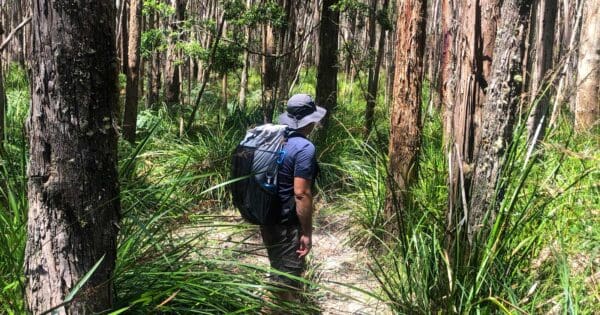Why gloves matter on the trail (and which ones to choose)
So you’re planning a hike in Australia – land of sun-kissed beaches, vibrant coral reefs, and…gloves? Yep, those humble hand protectors might not be the first thing that comes to mind, but in the diverse Aussie landscape, they can be surprisingly handy (pun intended).
But whether you’re traversing the snowy peaks of Tassie or navigating the sun-drenched Kakadu, picking the right gloves is crucial. It’s not just about keeping warm; it’s about grip, sun protection, and ultimately, a more comfortable and enjoyable hike.

Why do hikers wear gloves?
There are several reasons why you might consider wearing gloves on your hikes, and the specific reasons depend on factors like the weather, terrain, and chosen activity. Here are some of the main reasons hikers may wear gloves:
Protection from the elements:
- Cold: Hiking gloves, especially ones made with fleece, wool, or synthetic insulation, help keep your hands warm in cold weather. This is especially important for high-altitude hikes or winter treks.
- Wind: Windproof gloves with membranes like Gore-Tex can block chill winds and prevent windchill from stealing your hand warmth.
- Rain: Waterproof gloves keep your hands dry in wet weather, ensuring better grip and preventing them from getting cold and uncomfortable.
- Sun: Sun gloves, often fingerless, offer sun protection to prevent sunburn and premature aging on your hands. This is particularly important for long hikes in sunny environments.
Grip and dexterity:
- Gripping hiking poles: Hiking gloves with padded palms and grippy materials provide better control and prevent blisters from rubbing against the poles.
- Handling equipment: Gloves can help you grip maps, cameras, and other gear more securely, especially in wet or cold conditions.
- Scrambling and climbing: For technical terrain, gloves can protect your hands from scrapes and scratches against rocks and vegetation.
Comfort and safety:
- Blister prevention: Gloves can help prevent blisters on your palms from repeated friction against trekking poles or other gear.
- Improved hygiene: Wearing gloves can help keep your hands clean when touching potentially dirty surfaces like rocks or railings.
- Fingernail protection: Long fingernails can be prone to breakage or tearing, especially in technical terrain. Gloves can offer some protection.
So, while gloves might not be an essential item for every hike, they can significantly improve your comfort, safety, and overall enjoyment on the trail, especially in challenging weather conditions or strenuous activities.

Navigating the glove maze
Fleece: Your go-to for mild weather hikes. Warm, breathable, and comfy, these gloves offer basic protection from the sun and light scratches. Just don’t expect them to conquer icy winds or treacherous scrambles.
Windproof: If the wind howls like a banshee on your chosen trail, opt for windproof gloves. They’ll keep your digits toasty even when the gusts bite, often featuring a membrane like Gore-Tex for added breathability.
Waterproof: Rain showers come uninvited sometimes, and wet hands make for miserable trekking. Waterproof gloves with a decent dexterity score are your rainy-day saviour. Remember, though, complete waterproofness often sacrifices breathability.
Insulated: Conquering the snowy heights? Insulated gloves are your best bet. Think down, wool, or synthetic fillings for maximum warmth, but be prepared for bulkier fingers and less flexibility.
Fingerless: Want the dexterity to fiddle with your phone or map without removing your gloves? Fingerless gloves offer sun protection and light scratch protection while keeping your fingertips free. Perfect for warm but potentially prickly hikes.
Material Matters:
Wool: Natural, breathable, and surprisingly warm, wool is a classic choice for many hikers. It wicks away moisture and doesn’t get clammy, even with increased exertion.
Synthetics: Lightweight, quick-drying, and often water-resistant, synthetic materials like polyester and nylon are popular for their practicality. Just beware of potential sweating issues on long treks.
Leather: Durable and stylish, leather gloves offer excellent grip and sun protection. However, they can be expensive, not very breathable, and require upkeep to stay supple.

What gloves are best for hiking?
Ultimately, the best gloves for you depend on your specific needs and preferences. Remember, there’s no one-size-fits-all solution. I actually have multiple pairs of gloves that I use for different reasons. Consider the factors mentioned above and choose a pair (or pairs) that offers the right balance of protection, dexterity, and comfort for your next adventure! Consider these factors each time you hike to help you determine the best gloves for your adventure:
- Weather: Will you be battling blizzards or basking in sunshine?
- Terrain: Is it a gentle stroll or a technical scramble?
- Activity: Climbing? Using poles? Each activity might require different features.
- Personal preference: Do you prioritise warmth, dexterity, or sun protection?
Next time you’re packing for an Aussie adventure, don’t underestimate the humble glove. With the right pair, you can tackle any terrain, stay comfortable, and protect your precious digits from the elements. Now go forth and explore, hand in hand with the perfect gloves.






I use Mountain biking gloves when needed
I use light-weight cross country ski gloves when it gets uncomfortably cold. My current pair are from OR.